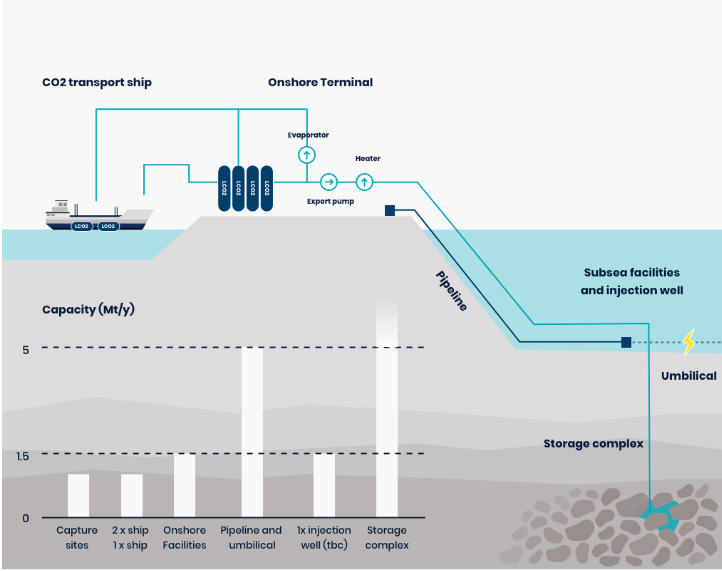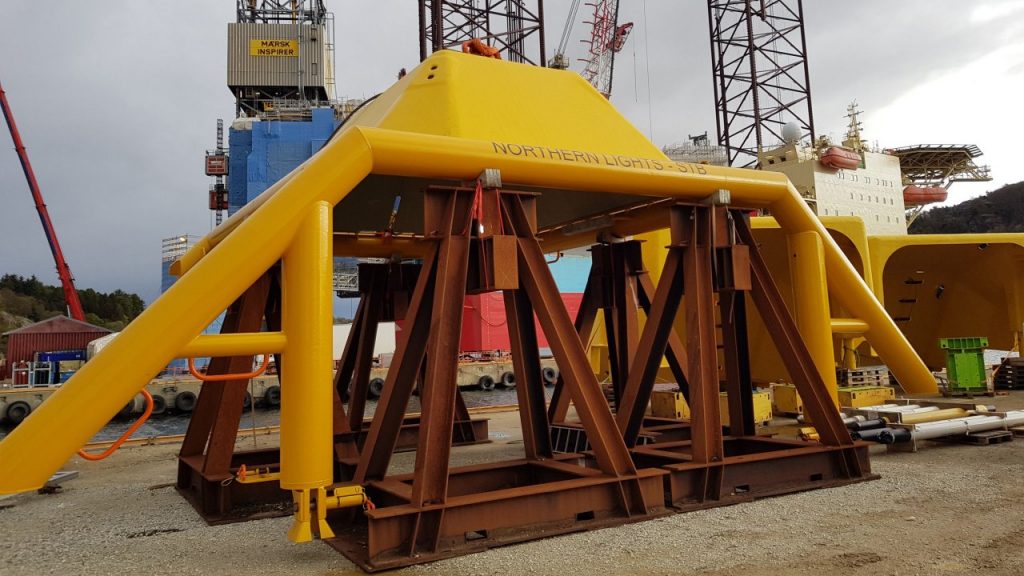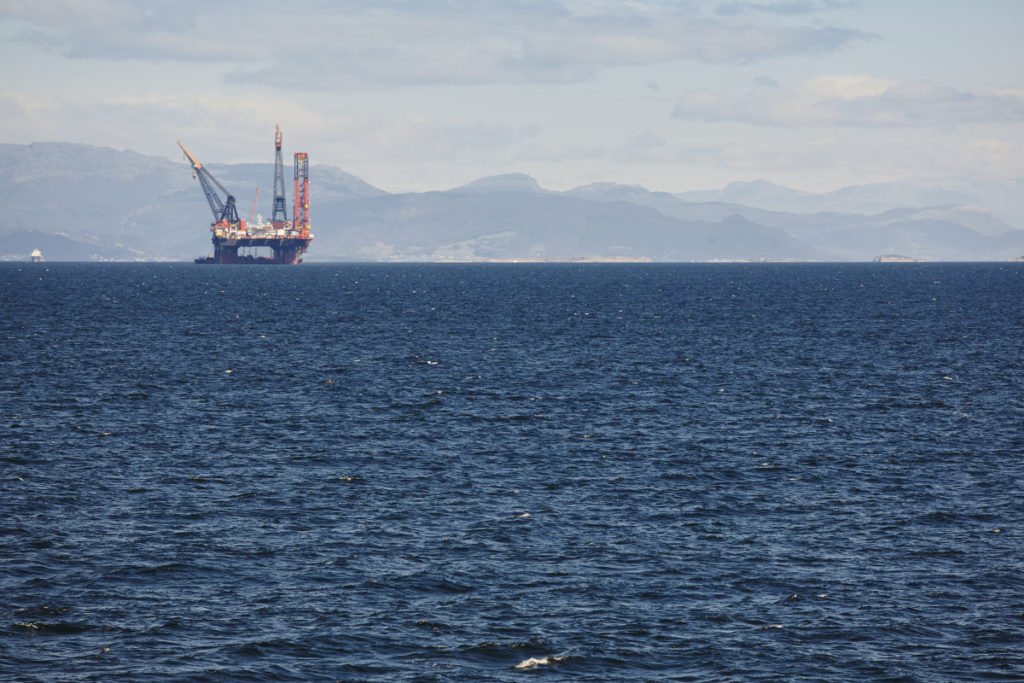Funding for Longship approved
December 14, the Norwegian Parliament adopted the budget for the Ministry of Petroleum and Energy for 2021, in line with what was proposed from the Government.

Heidelberg Materials has signed contracts with Aker Carbon Capture
Heidelberg Materials has signed a series of contracts with Aker Carbon Capture for delivery of the worlds first CCS plant at a cement factory.

15 years’ work behind the Longship storage site
Gassnova, Equinor and the Norwegian Petroleum Directorate have for many years collaborated on the development of the subsea CO2 storage that the Longship project will use.

Illustration: OED
About Longship
On September 21st this year, the Norwegian authorities “launched” the Norwegian CCS value chain project “Longship”, which includes capture, transport and storage of CO2.
Stored in the Johansen formation
The CO2 will be stored in the Johansen formation south of the Troll field, and behind the establishment of this storage is many years of work.
Norway has extensive experience with storage of CO2 in geological structures. Since 1996, about one million tonnes of CO2 have been captured each year from the hydrocarbon gas produced on the Sleipner West field in the North Sea.
The CO2 storage in the Johansen formation in exploitation permit 001 (EL001) will be the third subsea CO2 storage developed in Norway.
It can take several years to mature a possible CO2 storage until it is ready to receive an injection of CO2 . The timeline presented in the article below shows all the measures taken prior to the decision to submit a plan for development and operation (PDO) for transport – and the storage part of the project – with the name Northern Lights.
The process of finding a possible CO2 storage facility for the Longship project began with a review of the Norwegian continental shelf in 2007. This was then matured through several stages, and will continue in the future as more CO2 storage facilities are expected to be developed.
The whole story – 2005-2020
Ready to realize full chain carbon capture and storage
In a Government White Paper to the Norwegian parliament submitted today, the Government proposes to launch a carbon capture and storage (CCS) project in Norway.

-We are very pleased with the government’s recommendation. The government proposes to first realize the capture of CO2 (CCS) at Heidelberg Materials’s cement factory in Brevik. The Government also plans to support the capture of CO2 at Fortum Oslo Varme’s waste management facility in Oslo, provided that this project first obtains sufficient self-financing and financing from the EU or other sources. The Government’s decision is based on extensive work carried out by Gassnova and the industrial partners we have collaborated with over the past five years. The decision is also inspiring for all our skilled and committed employees, who have worked to help us now realize full-scale CCS in Norway, says Trude Sundset, Gassnovas CEO.
Here you can read more about Gassnova’s reports and recommendations
Press release from the Norwegian Ministry of Petroleum and Energy
Important milestone in the CO2 storage project
The Ministry of Petroleum and Energy has received and started our assessment of the development plan for the Northern Lights CO2-storage project.

– Carbon capture and storage (CCS) is important for achieving the goals of the Paris Agreement. The submission of the development plan is a necessary step in order to realize full-scale CO2-capture and storage in Norway. The Northern Lights project will also be able to offer CO2 storage from other countries. Northern Lights is an example of the expertise and experience we have built up in the oil and gas industry being used in the development of new technology and new solutions that ensure sustainable use of energy. Hywind Tampen, which was just approved by the authorities, is another such example, says Minister Tina Bru.
Read the full press release from the Norwegian Ministry of Petroelum and Energy here
– The Norwegian CCS project is in many ways a European project, since the planned storage facility in the North Sea will have room for CO2 from all across Europe. An important milestone for the Norwegian full-scale project has now been passed since the Northern Lights consortium has submitted their development plan to the authorities, says Gassnova’s CEO Trude Sundset.
For more information about the Norwegian Fullscale CCS Project: ccsnorway.com
For more information about the Northern Lights part of the project: https://northernlightsccs.com/
Northern Lights well completed
Equinor and partners Shell and Total have completed the drilling of confirmation well 31/5-7 Eos south of the Troll field in the North Sea. The purpose was to determine the suitability of the reservoir in the Johansen formation for CO2 storage.

Read the press release from Equinor here
Ambitious goals
The Norwegian Government’s policy platform from Granavolden (January, 2019) states that it will “develop technology for capture and storage of CO2 and have an ambition of realizing a cost effective solution for full-scale CCS in Norway, provided that the project leads to technology development in an international perspective “.

“It was in 1996 that Statoil (now Equinor) commenced CO2 storage deep under the sea bed in the Utsira formation of the North Sea.”
This project, called the Sleipner CCS Project, was triggered by one of the world’s first carbon taxes, introduced for the oil and gas sector by the Norwegian Government in 1991.
Since that first successful large-scale demonstration of CO2 storage, the Norwegian government, industry and academia have continued to develop CCS in multiple ways. This work was made possible by financing from the Norwegian Government, in the form of research programmes and direct subsidies, and by co-financing by the industry.
In 2012, the world’s largest test centre for CO2 capture, Technology Center of Mongstad (TCM), was inaugurated.
While TCM has proven to be a success, the Full-scale CCS project in Norway will take the research and achievements to the next level – making them practical, applicable and appealing to the rest of the world.
This political willpower and investment have been combined with Norway’s natural geographical advantages, which are by no means unique. The storage potential of offshore Norway, where oil and gas have been trapped under sealing rock formations for millions of years, is enormous. The Norwegian Petroleum Directorate has already mapped the CO2 storage potential of the Norwegian continental shelf.
Project goals
The Norwegian Government’s policy platform from Granavolden (January, 2019) states that it will “develop technology for capture and storage of CO2 and have an ambition of realising a cost-effective solution for full-scale CCS in Norway, provided that the project leads to technology development in an international perspective”.
Consequently, the long-term goal for the Full-scale CCS project in Norway is simple.
“The project shall contribute to the development of CCS in order to reach long term climate goals in Norway and the EU in a cost-effective manner.”
In the short-term the Full-scale CCS project in Norway’s objective is to demonstrate that CCS, as a climate mitigation tool, can be implemented – technically, regulatory and commercially. It will also demonstrate that CCS is safe, by monitoring injection wells and by avoiding emissions from the capture site.
Commercial viability will require government support for this project, but cost reduction and business model development will be key for further deployment of CCS. The Full-scale CCS project will reduce the cost of future projects by sharing knowledge and experiences, and by establishing an infrastructure for CO2 transport and storage, with spare capacity.
The Full-scale CCS project in Norway also aims to serve as a platform for further business development for future projects, as it enables further development of other low carbon products.
The Full-scale CCS project in Norway is actively working to achieve these project goals. All industrial partners are involved in this program, which has been named “benefits realisation”. Gassnova is coordinating this work program.
Why Norway
Norway has more than 20 years of experience with CO2 storage. CCS research and development a prioritized area for the governments in this oil-rich nation for decades.

With a large, natural geological CO2 storage capacity area under the North Sea and more than 20 years of experience with CO2 storage, Norway is in a strong position to demonstrate CCS at scale.
Sedimentary basins all over the world provide similar opportunities.
CCS is one of several climate priorities for the Norwegian Government, which has set an ambition to demonstrate CCS for as long as the technology has international relevance.
The Full-scale CCS project in Norway seeks to fulfill the objectives of both Government and industry by reducing investment barriers for business and developing sustainable value creation opportunities.
Reducing barriers
If the world has agreed climate targets and there is a growing consensus among international bodies that CCS is needed to achieve them, why has CCS not already taken off?
The reality is that to date there has been a lack of investment in industrial CCS and CCUS projects. The very same IEA, UN and EU reports which extol the virtues of CCS have also been quick to point this out.
This lack of commercialization has primarily been driven by several CCS specific market failures. So there is an obvious need for cooperation between the private and the public sectors to overcome market hurdles to increase investment in CCS implementation.
How then, do we unlock this investment? The key lies in demonstrating CCS to prove that it is viable, building open-access CO2 infrastructure and developing public-private cooperation.
“The first demonstration project will serve as a platform for further innovation in technology, business models, regulations and policy.”
The Norwegian Contribution
CCS and CCUS has been proven to be technically viable in several existing projects around the world. Globally, there are large-scale CCUS projects already in operation, such as the. Equinor Sleipner-project, the SaskPower Boundary Dam-project and the Shell Quest-project.
All of these projects are incredibly useful and the Full-scale CCS project will be building on the lessons that have been learned and shared as CCS technology has developed over the years. In addition, the Full-scale project aims to address more of the market failures which have so far held up investment in CCS as a broad climate mitigation tool. The Full-scale CCS project aims to do this by:
- Demonstrating the full CCS chain as a climate mitigation tool;
- Establishing an open access transport and storage infrastructure with spare capacity;
- Capturing CO2 from a cement factory and/or a Waste to Energy (WtE) plant, including capture from partial bio sources
- Testing CCS under the condition of relevant EU regulation.
The Full-scale project is also driven by public-private cooperation with a shared responsibility for investment. Each industrial partner is responsible for designing their own project, while the state coordinates and creates a framework for each partner’s role.
